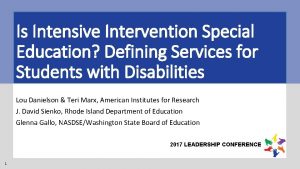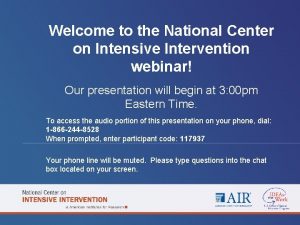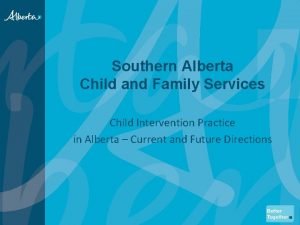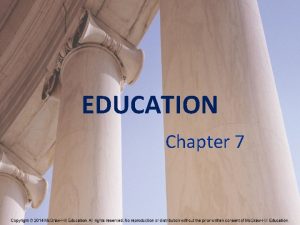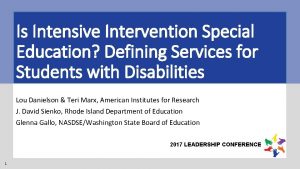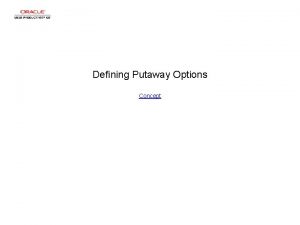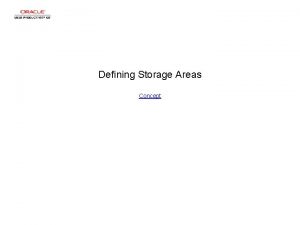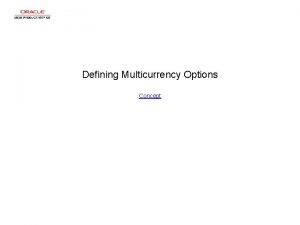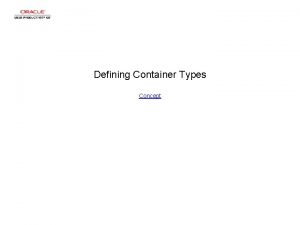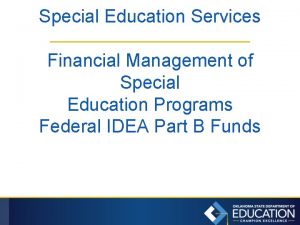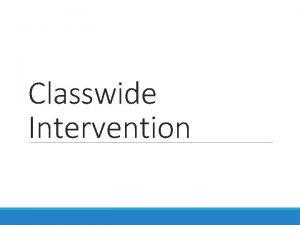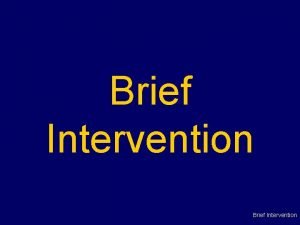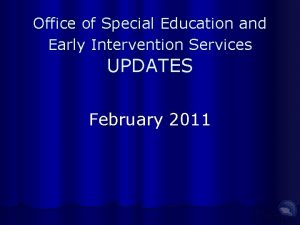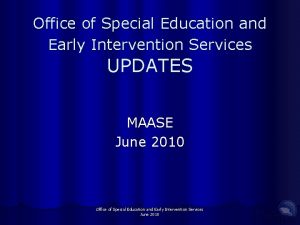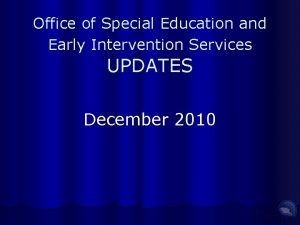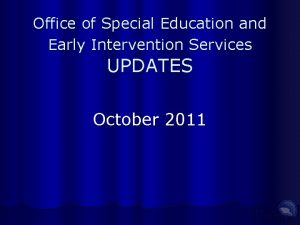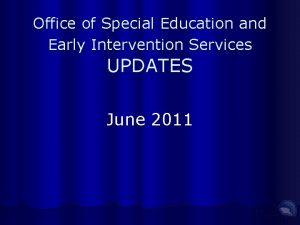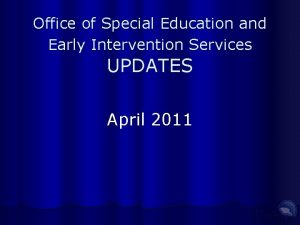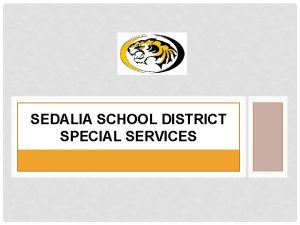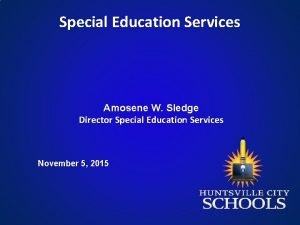Is Intensive Intervention Special Education Defining Services for







































- Slides: 39

Is Intensive Intervention Special Education? Defining Services for Students with Disabilities Lou Danielson & Teri Marx, American Institutes for Research J. David Sienko, Rhode Island Department of Education Glenna Gallo, NASDSE/Washington State Board of Education 2017 LEADERSHIP CONFERENCE 1

No Time Like the Present • Recent Supreme Court ruling – potential implications: • In the future, progress (documented through data) on an IEP could be the foundation for ascertaining if the FAPE standard was met. • Pushes educators to provide higher quality instruction to ensure that students with disabilities meet challenging standards. 2 2017 LEADERSHIP CONFERENCE

Defining Special Education 2017 LEADERSHIP CONFERENCE 3

How does your State… …define special education? 4 2017 LEADERSHIP CONFERENCE

Specially-Designed Instruction (SDI) • “adapting, as appropriate to the needs of an eligible child under this part, the content, methodology or delivery of instruction (i) to address the unique needs of the child that result from the child’s disability; and (ii) to ensure access of the child to the general curriculum, so that the child can meet the educational standards within the jurisdiction of the public agency that apply to all children. ” (Section 300. 39(b)(3) of Title 34, Code of Federal Regulations). 5 2017 LEADERSHIP CONFERENCE

Standards-Aligned IEPs and SDI (RI) Step 1: What are the Common Core State Standards (CCSS)? Step 2. Assess Student to Determine Where Student is Functioning in all areas Step 3. Use Data to Establish Present Levels of Functional Performance and Academic Achievement in all areas Step 4. Prioritize and Use Present Levels of Performance to Develop Goals Step 5. Establish Type of Data to be Collected, How Often, and Progress Monitoring 6 2017 LEADERSHIP CONFERENCE

SDI in Rhode Island Step 6. - Identify Specifically Designed Instruction and Include Related Services - Identify the instruction and classroom assessment Accommodations and Program Modifications to Provide Access and Progress in the General Curriculum - Identify Assistive Technology devices and services need for instructions or assessment - Determine Accommodations for State and Local Assessment Example of Specially designed instruction: Supplemental systematic intensive small, group instruction using evidence based reading strategies for informational text and vocabulary. 1. 5 hours per day/5 days per week/4 weeks per month 7 2017 LEADERSHIP CONFERENCE

SDI in Utah Is… Is Not… In addition to core instruction (supplemental) A service What a teacher does Based on teaching specific skills a student does not have in order to access and make progress in the general curriculum • Unique instruction written into the IEP that is provided to the student to allow him/her to progress toward annual goal(s) • Specific to the student (individualized) • Instruction that allows a student to make progress in the general curriculum and close the gap in academic performance as compared to his/her general education peers • In place of core instruction (supplant) • • 8 • A place • What a student does • Not a restatement of the academic content standards being taught • A commercial program • A schedule • An excuse for setting low expectations or teaching below grade level (not making grade level content available/accessible to students with disabilities) 2017 LEADERSHIP CONFERENCE

Setting the Stage for SDI 2017 LEADERSHIP CONFERENCE 9

What Makes… …special education different from other supports provided to students? 10 2017 LEADERSHIP CONFERENCE

Multi-tiered System of Supports (MTSS) 11 2017 LEADERSHIP CONFERENCE

State Perspectives In MTSS, educators implement with fidelity the hallmarks of both RTI and PBIS into a merged model to improve student outcomes. • Team approach • Universal screening • Data-based decisions • Evidence-based practices • Progress monitoring 12 2017 LEADERSHIP CONFERENCE

How are You… …currently supporting students who are non-responsive or persistently struggling? 13 2017 LEADERSHIP CONFERENCE

State Systemic Improvement Plan – Implementation Efforts • Support for LEA Implementation of Evidence-Based Practices (EBPs) Pilot projects based on LEA data and needs Intensive support provided by USBE Book study with administrators, educators, and parents/families Facilitate an annual co-teaching cohort of general and special education teachers focusing on both EBPs in co-teaching, as well as mathematics content, instruction, and intervention using EBPs • Workshops, webinars and lesson studies on the implementation of EBPs in mathematics • Professional development on Universal Design for Learning • Align courses for special education preservice programs and mathematics endorsement courses • • 14 2017 LEADERSHIP CONFERENCE

15 2017 LEADERSHIP CONFERENCE

A Common, Data-Driven Process 2017 LEADERSHIP CONFERENCE 16

The National Center on Intensive Intervention (NCII) 2017 LEADERSHIP CONFERENCE

18 2017 LEADERSHIP CONFERENCE

More Help Validated programs are not universally effective programs; 3 to 5 percent of students need more help (Fuchs et al. , 2008; NCII, 2013). 19 More Practice Students with intensive needs often require 10– 30 times more practice than peers to learn new information (Gersten et al. , 2008). 2017 LEADERSHIP CONFERENCE

What is Intensive Intervention? Intensive intervention addresses severe and persistent learning and/or behavior difficulties. Driven by data 20 Characterized by increased intensity and individualization 2017 LEADERSHIP CONFERENCE

Intensive Intervention… Is… • Individualized based on student needs • More intense, often with substantively different content AND pedagogy • Involves more frequent and precise progress monitoring 21 Is Not… • A single approach • A manual • A preset program • Always one on one instruction • More of the same Tier 1 instruction • More of the same Tier 2 instruction 2017 LEADERSHIP CONFERENCE

Students who Need Intensive Intervention • Not meeting IEP goals • Persistently low academic achievement • High frequency/intensity behavior • Nonresponsive to interventions delivered with fidelity 22 2017 LEADERSHIP CONFERENCE

“Comorbidity is the rule, not the exception. ” 23 2017 LEADERSHIP CONFERENCE

Data-Based Individualization (DBI) 24 2017 LEADERSHIP CONFERENCE

DBI Integrating databased decision making across academics and social behavior 25 2017 LEADERSHIP CONFERENCE

More Than Just Collecting the Data 2 2017 LEADERSHIP CONFERENCE 6

What does it take to implement DBI in LEAs? Essential Elements 27 2017 LEADERSHIP CONFERENCE

Discussion Questions • Are your definitions of special education similar? Different? • What makes special education different from other supports provided to students? • Is special education truly the most intensive level of support provided? How do you know? • Do you provide guidance around a process/approach similar to DBI to your LEAs? • What questions do you still have? 28 2017 LEADERSHIP CONFERENCE

WWW. INTENSIVEINTERVENTION. ORG 29 2017 LEADERSHIP CONFERENCE

Tools Charts • Academic Intervention • Academic Progress Monitoring • Behavior Intervention • Behavior Progress Monitoring • Academic Screening • Coming Soon: • Behavior Screening • Postsecondary Transitions (potential) 30 2017 LEADERSHIP CONFERENCE

Implementation Resources: Training Materials os ide V t r xpe E e th Ask ies r e g. S in n i a I Tr DB ars n ebi W 31 2017 LEADERSHIP CONFERENCE

Implementation Resources: Data Meetings 32 2017 LEADERSHIP CONFERENCE

Implementation Resources: Fidelity Materials 33 2017 LEADERSHIP CONFERENCE

Instructional Resource: Graphing Tool 34 2017 LEADERSHIP CONFERENCE

Instructional Resources: Guides 35 2017 LEADERSHIP CONFERENCE

Instructional Resources: Math Videos 36 2017 LEADERSHIP CONFERENCE

Stay Up to Date: Newsletter • Sign up for our Newsletter and email list to receive regular updates 37 2017 LEADERSHIP CONFERENCE

Disclaimer • This module was produced under the U. S. Department of Education, Office of Special Education Programs, Award No. H 326 Q 160001. Celia Rosenquist serves as the project officer. The views expressed herein do not necessarily represent the positions or policies of the U. S. Department of Education. No official endorsement by the U. S. Department of Education of any product, commodity, service, or enterprise mentioned in this website is intended or should be inferred. 38 2017 LEADERSHIP CONFERENCE

Contact US Teri Marx, Ph. D. tmarx@air. org National Center on Intensive Intervention 1000 Thomas Jefferson Street NW Washington, DC 20007 -3835 www. intensiveintervention. org ncii@air. org @The. NCII 2017 LEADERSHIP CONFERENCE
 Defining non defining relative clause
Defining non defining relative clause Relative clauses defining and non defining
Relative clauses defining and non defining Defining and non-defining
Defining and non-defining Defining relative clause meaning in telugu
Defining relative clause meaning in telugu Relative clauses örnekleri
Relative clauses örnekleri Non defining relative clause
Non defining relative clause National center on intensive intervention
National center on intensive intervention National center on intensive intervention
National center on intensive intervention Southeast cfs
Southeast cfs Government intervention in education
Government intervention in education Fspos
Fspos Novell typiska drag
Novell typiska drag Nationell inriktning för artificiell intelligens
Nationell inriktning för artificiell intelligens Ekologiskt fotavtryck
Ekologiskt fotavtryck Varför kallas perioden 1918-1939 för mellankrigstiden?
Varför kallas perioden 1918-1939 för mellankrigstiden? En lathund för arbete med kontinuitetshantering
En lathund för arbete med kontinuitetshantering Personalliggare bygg undantag
Personalliggare bygg undantag Tidböcker
Tidböcker Sura för anatom
Sura för anatom Densitet vatten
Densitet vatten Datorkunskap för nybörjare
Datorkunskap för nybörjare Stig kerman
Stig kerman Hur skriver man en tes
Hur skriver man en tes Magnetsjukhus
Magnetsjukhus Nyckelkompetenser för livslångt lärande
Nyckelkompetenser för livslångt lärande Påbyggnader för flakfordon
Påbyggnader för flakfordon Arkimedes princip formel
Arkimedes princip formel Offentlig förvaltning
Offentlig förvaltning I gullregnens månad
I gullregnens månad Presentera för publik crossboss
Presentera för publik crossboss Teckenspråk minoritetsspråk argument
Teckenspråk minoritetsspråk argument Bat mitza
Bat mitza Treserva lathund
Treserva lathund Fimbrietratt
Fimbrietratt Bästa kameran för astrofoto
Bästa kameran för astrofoto Centrum för kunskap och säkerhet
Centrum för kunskap och säkerhet Byggprocessen steg för steg
Byggprocessen steg för steg Mat för idrottare
Mat för idrottare Verktyg för automatisering av utbetalningar
Verktyg för automatisering av utbetalningar Rutin för avvikelsehantering
Rutin för avvikelsehantering






